Zoology
1/70
Earn XP
Description and Tags
BIO2040: Prof. Pedro Quijon
Name | Mastery | Learn | Test | Matching | Spaced |
|---|
No study sessions yet.
71 Terms
Naturalists
Jane Goodall
Sir David Attenborough
Edward Wilson
Jane Goodall
Researched Tanzanian Chimpanzees
basically clarified the connection between anthropology and primatology
Sir David Attenborough
The Voice of Biology
brought attention to wildlife, endangered species and climate change as the iconic voice of BBC and National Geographic documentaries
Edward O. Wilson
“Founder” of Biodiversity
the “bug guy” that wrote many many books on conservation and first proposed the term biodiversity
Definition: Biodiversity
the variation within the same ecosystem
a very vast concept, har to fully grasp
Definition: Evolution by Natural Selection
the change in characteristics of a population over the course of many generations as a result of environmental pressure
Fathers of Evolution
Charles Darwin
Russell Wallace
Both proposed Evolution by Natural Selection at around the same time, the only real difference was where they studied and social status
Russell Wallace
Analyzed the biodiversity of insects in North Africa before travelling to Indonesia where he studied the change in diversity along tectonic plates
The Wallace Line
the dividing line across the Indonesian archipelago that divides the Oriental Fauna and Australian Fauna
Charles Darwin
studied the species in the Galapogos and their characteristics (the diversity within the island species)
explained the differences between the mainland and island fauna
Objection to the Theory of Evolution (at the time)
2 primary objections from the scientific community at large
did not explain the origin of these changes
did not explain how the changes were passed along generations
Gregor Mendel would have resolved these objections in seconds but Darwin never read his letter
Breaking-Down Darwin’s Theory
the Theory of Evolution by Natural Selection really contains 5 Key Theories
Perpetual Change
Common Descent
Multiplication of Species
Gradualism
Natural Selection
1: Perpetual Change
living organisms are not constant or immutable, they change
best supported by the fossil record, diseases and medicine
disproved/rejected Creationism
2: Common Descent
“life is a branching tree where… large branches (original) split into small (derived) ones”
created the field of Systematics
3: Multiplication of Species
the concept that when habitats change opportunities for new species or adaptations form → this allows one species to become multiple
Adaptive Radiation for example
4: Gradualism
the concept that change among populations is a continuous cumulative process
gave rise to: Punctuated Equilibrium
5: Natural Selection
1-populations are fertile
2-resources are limited
3-survival is differential favouring fittest individuals
Typological Species Concept
based on morphological similarities (homology) and can generally be visually distinguished
Biological Species Concept
based on similarity of appearance, niche and ability to INTERBREED and produce viable offspring
Evolutionary Species Concept
based on similarity of appearance, niche, ability to interbreed to produce viable offspring and has EVIDENCE of ANCESTRY
Phylogenetic Species Concept
based on similarity of appearance, niche, ability to interbreed to produce viable offspring, evidence of ancestry and the presence/absence of RECOGNIZABLE GENETIC VARIATION
Allopatric Speciation
speciation by SPATIAL or TEMPORAL barriers
Sympatric Speciation
speciation by NICHE or BEHAVIOURAL barriers
Mutation Speciation
could be allopatric or sympatric
Criteria of a RECOGNIZED Species
An Official Binomial Name
a unique and specific name
An Official Description
published in an accepted scientific publication
An Official Type
an “average appearance” used to compare other species against
usually a preserved specimen
The Animal Concept
the definition of what an animal is
based around 4 major characteristics:
Eukaryotic
Absence of Cell Wall
Heterotrophic
Multicellular
slight variation exists within these for situations like Symbiosis and Developmental Stages
Animal Complexity
differences in complexity and size relates to multicellularity (large=multi and small=uni) this is because complexity requires increased metabolism and metabolism requires a high SA:V ratio
Impact of Complexity on Cells
generally speaking complexity…
reduces the average cell size
increases cell specialization
increased inter-cellular dependency
Tissues
specialized groups of cells for transport and delivery of oxygen, nutrients, water, residuals, etc. which are essential to proper absorption, excretion and respiration of cells
4 Types of Tissues
Epitelial
Connective
Muscular
Neural
Phylum Porifera
the simplest animals
aquatic filter feeders with a basic morphology
DIPLOBLASTIC
2 germ layers, endoderm and ectoderm plus Mesoglea/Mesohyl
inculdes ~ 8,500 species
ecologically significant
water quality (filter feeding)
habitat (as the habitat)
Porifera ASEXUAL Reproduction
2 methods → NO GAMETES
FRAGMENTATION
a portion of the sponge detached and builds a new one
GEMMULAS
‘seeds, filled with amoebocytes that are sealed during harsh conditions, are released when conditions improve
Porifera SEXUAL Reproduction
HERMAPHRODITES WITH GAMETES
sperm are derived from the choanocytes
oocytes are derived from the archaeocytes
fertilization produces an egg, that hatches a free-living Larva which will eventually settle to form a new sponge
2 Methods of Sponge Fertilization
EXTERNAL
sperm and oocytes are released into the water coloumn
INTERNAL
sperm is released into the water and caught by another sponge and coved into the mesoglea where the oocyte is
Body Shapes of Porifera
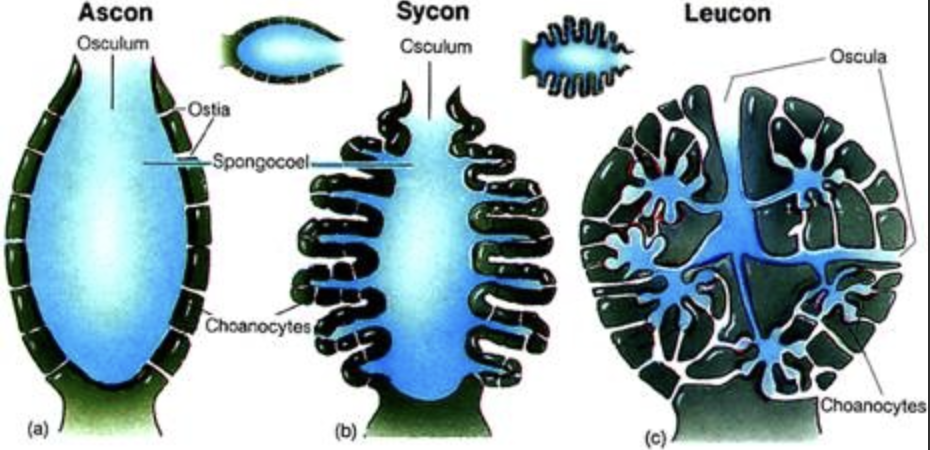
Cells of Porifera
Choanocytes
Amoebocytes
Spicules
Sclerocyte
Pinacocyte
Porocyte
Archaeocyte
Choanocytes
“collar cells”
the main and most unique cells in sponges
can be distinguished by their FLAGELLUM and COLLAR
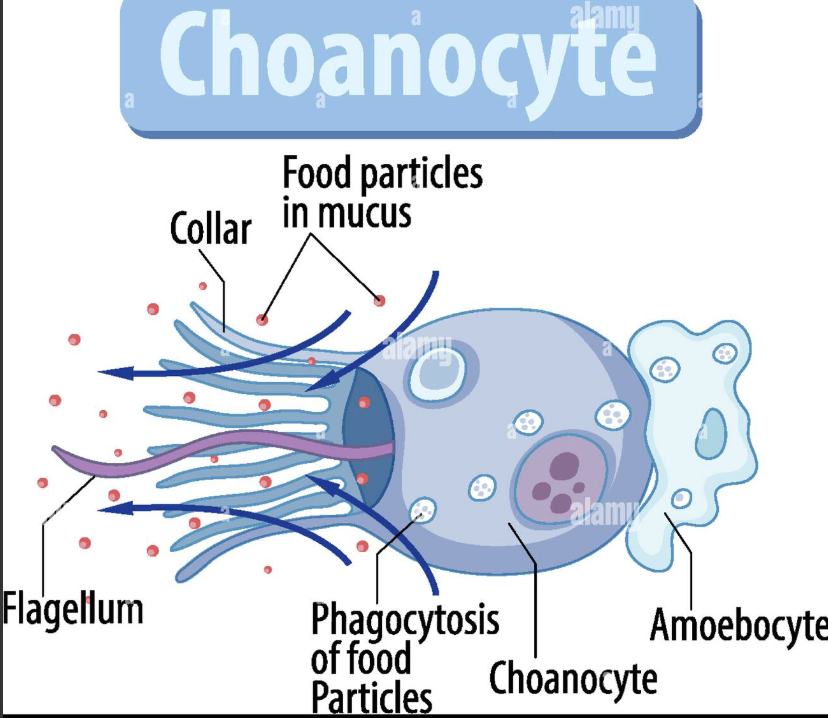
Amoebocytes
multipurpose cells associated with choanocytes
mainly handle digestion of food particles
Spicules
the ‘skeleton’ of the sponge
Sclerocyte
the cell that secretes the spicules
Pinacocyte
T shaped ‘epithelial’ cells
Porocyte
water-flow regulation cell
Archaeocyte
the amoebocyte for (digestion/reproduction)
Classes of Porifera
Calcarea
Hexactinellida
Demospongiae
based on shape and mineral composition of spicules
Types of Animal Symmetry
Spherical
Radial
Bilateral
Spherical Symmetry
typical of many protosoans (not so much in animals)
body can be divided by
INFINITE PLANES
Radial Symmetry
mainly cnidarians and ctenophores (the round/tubular animals)
body can be divided by
TWO OR MORE PLANES
Bilateral Symmetry
most animals
body can be divided into left and right
introduces 2 key changes:
Polarity of Development
anterior vs posterior distinguished
Centralized Sensory Organs
cephalization
ONLY ONE PLANE
Phylum Cnidaria
radial symmetry
tissues are better developed but still DIPLOBLASTIC (two germ layers)
start of specialized cells and basic ‘organs’
first to have a GASTROVASCULAR CAVITY
where extra-cellular digestion happens
lined by endoderm
Have one type of cell specific to cnidarians
CNIDOCYTES
Cnidarian Body Types
Polyp
opening up
Medusa
opening down
Germ Layers of Cnidaria
ENDODERM
‘internal skin’
lines the inner organss
MESOGLEA/MESOHYL
a matrix with cells and fibres
works as a hydrostatic skeleton to keep its shape while floating/drifting
ECTODERM
epidermis with a net of sensory cells
ocelli, statocytes
found under the bell/umbrella of cnidarians
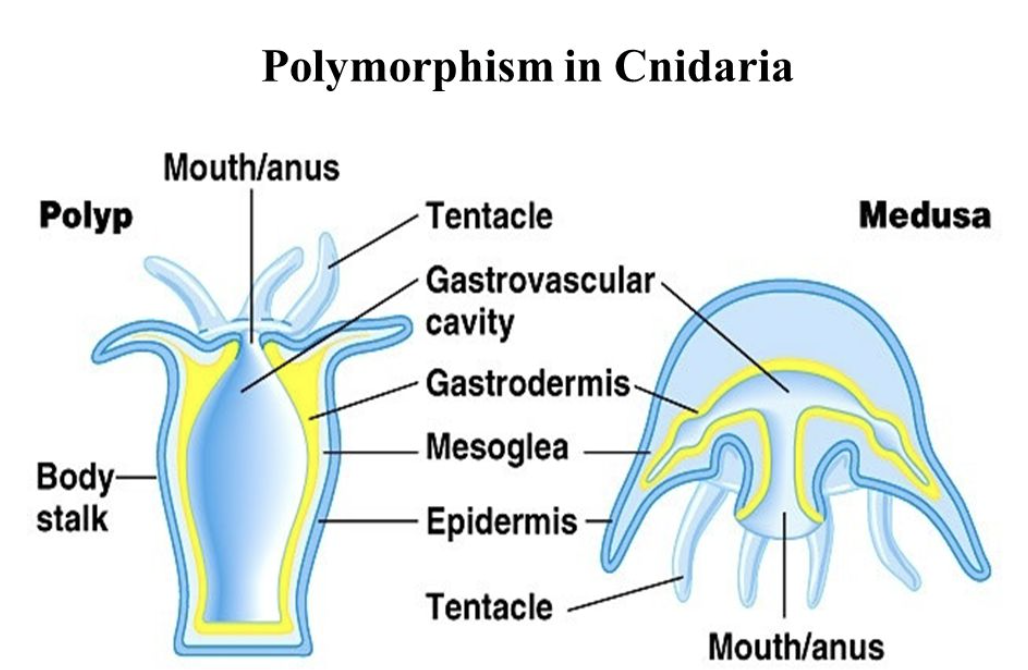
Cnidocytes
special cnidarian cells for hunting mostly
have HARPOON-LIKE structures called NEMATOCYSTS
Classes of Cnidaria
HYDROZOA
SCYPHOZOA
ANTHOZOA
HYDROZOA
body types are both prominant
3,000 species (pretty high for a single class)
2 model species:
OBELIA → colonial
HYDRA → non-colonial
Life Cycle of Obelia
2 Phases
Asexual
Sexual
many types of polyps
GASTROZOIDS (the feeding polyps)
GONOZOIDS (medusa growing polyps)
this organism looks like flowers
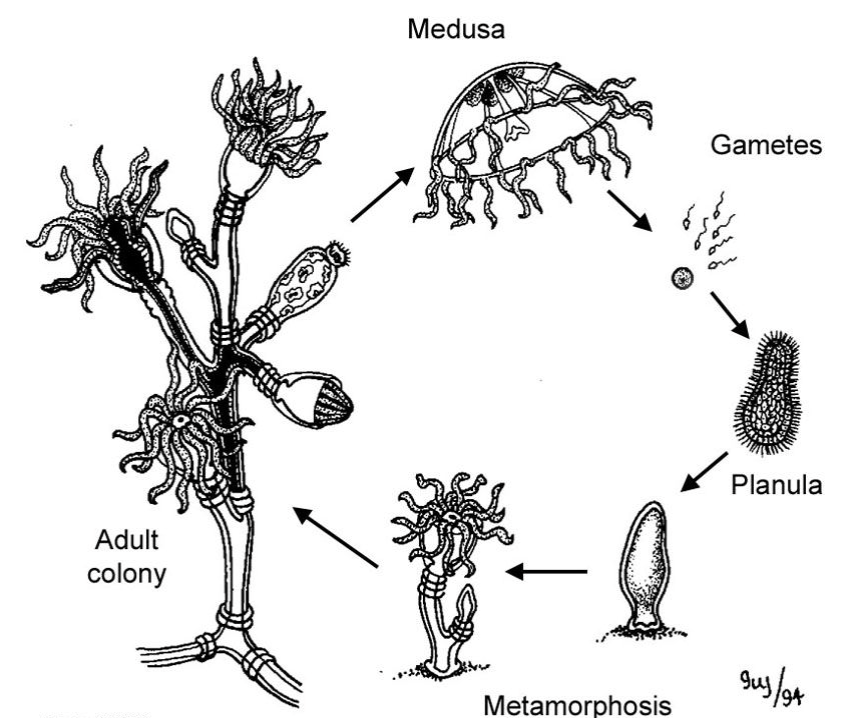
Other Colonial Hydrozoans
Velella → prioritizes medusa phase
Physalia
SCYPHOZOA
both body types present but MEDUSA is DOMINANT
200 species (not much diversity)
medusas are large but lack a velum
Life Cycle consists of 2 phases
asexual
sexual
ANTHOZOA
ONLY POLYP
only marine
4,000 species (highly diverse)
two main groups
Hexacorallia
Octocorallia
Hexacorallia Anthozoans
SIX BODY COMPARTMENTS
secrete a hard EXO-skeleton
which creates a rock to latch onto
create colonies called Coral Reefs
3 identifying structures:
Tentacles
Pharynx
Pedal Disc/Anchor
Live Symbiotically with Algae
zooxanthellae
usually live in and colonize shallow tropical waters
sea anemones and hard corals
Octocorallia Anthozoans
EIGHT BODY COMPARTMENTS
no exo-skeleton secretion only a soft ENDO-skeleton
soft corals and sea fans
Sub-Phylum Ctenophores
named after the 8-row COMBPLATES (called ctenes) these animals use for locomotion
do NOT HAVE nematocytes instead, COLLOBLASTS/STICKY CELLS along tentacles
primary carnivores predators that feed on plankton using tentacles
they are HERMAPHRODITIC and produce free-swimming larva called Cydippid
Phylum Platyhelmenthes/ Flatworms
BASED ON PLANARIA MODEL
bilateral symmetry
first bilateral animals
TRIPLOBLASTIC
with true mesoderm
have incomplete gastrovascular cavity (no anus)
intestines have extension structures called DIVERTICULA
have unique cells
majority are cephalized with ganglia and lateral nerve cord
Germ Layers of Platyhelmenths
ENDODERM
‘internal skin’
lines the inner organs
MESOODERM
parenchyma/middle tissue
these organisms have true mesoderm
ECTODERM
epidermis with a net of sensory cells
Rhabdites/Rhabdoids
cells unique to platyhelmenths
rod-like structures that produce ‘mucus’
this helps with locomotion and preventing desication
Proto-Nephridia
primitive kidney tissue
used by flatworms for excretion/waste management via diffusion
contain Flame Cells
responsible for filtering and getting rid of residuals
Platyhelmenth: Planaria Reproduction
two types:
Asexual
via fission with high capacity of regeneration
Sexual
hermaphrodites with cross-fertilization capacity
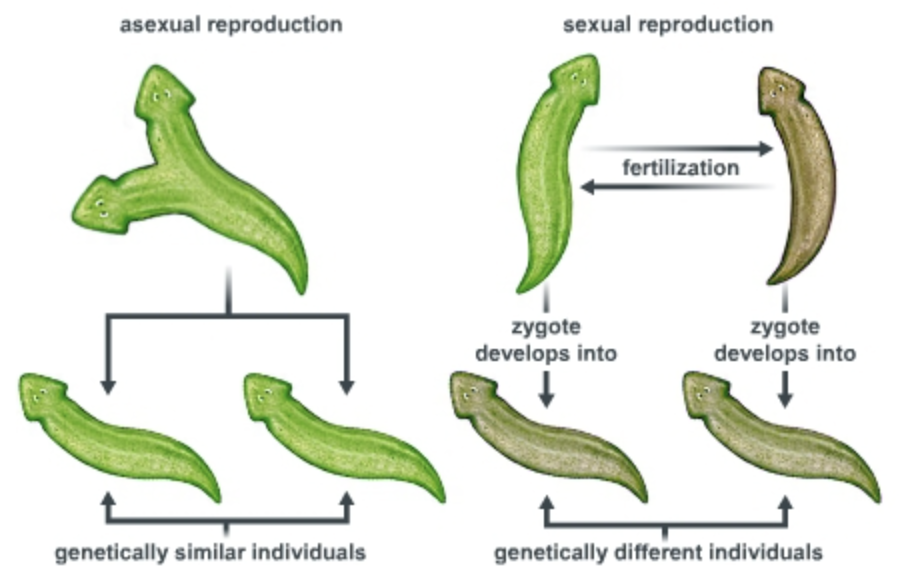
Adaptations of Parasitism
High Reproductive Ability
highly fertile
life cycle synchronized with the host
Attachment to Host
physical attachment organs (hooks and suckers)
physiological attachment (immune suppression/resistance)
Simplification/Reduction of Systems
able to use host metabolism
no need for “independent metabolism”
Types of Parasites
Single-Host
only one phase inside host + free-living phase
Multiple-Host
different stages in different hosts + free-living phase
Types of Hosts
Intermediate Host
holds eggs or larva
Final Host
holds adult parasite
Diversity of Platyhelmenthes
TURBELLARIA
free-living
freshwater and marine
MONOGENEA
ectoparasites (on fish)
single-host parasites
OPITHAPTOR organ used to attach to host (similar to external hooks)
DIGENEA/TERMATODA
use suckers